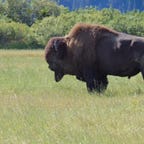How mammoths could save the world.
My newest book Project Hannibal is premised on the resurrection of mammoths — yes, mammoths — to help fight climate change. Sound far-fetched? It’s not as strange as it might sound.
To understand why, you have to understand the crucial role that permafrost plays in keeping our planet cool. Permafrost is the underground layer of Arctic soil that remains frozen year-round, decade after decade, century after century. That frozen soil makes the Arctic one of the largest carbon sinks in the world, trapping 1,400 gigatons of carbon. That’s about twice the entire amount of carbon currently contained in Earth’s atmosphere.
As climate change sends temperatures in the Arctic to unprecedented highs — over 100°F was recorded in Siberia last summer — large areas of permafrost are beginning to thaw. That thawing will release the greenhouse gases methane and carbon dioxide into the atmosphere, far outstripping our puny efforts to control carbon emissions. The result would have a cascade effect on the acceleration of planetary warming — warmer Arctic temps thawing more permafrost, releasing more greenhouse gases, leading to warmer temperatures and more thawing, in a disastrous spiral.
It’s no exaggeration to say that protecting the permafrost is vital to human survival on Earth.
So how could mammoths help?
Experiments have shown that large herds of grazing animals in the far North help keep soil temperatures cool. In summer, their grazing keeps the land covered in light-colored grasses instead of trees. That reflects the sun back into the sky instead of darker tree cover absorbing the sun’s heat. In winter, the herds compact the soil and tramp down the insulating layer of snow, allowing the cold to penetrate deeper into the earth.
And no herds would be better at that than mammoths.
Is it possible to revive extinct mammoths?
Mammoths are unique among the iconic extinct mammals in part because we have a wealth of biological material from mammoth carcasses that have been encased in Arctic ice since the last ice age. Efforts are underway to reconstruct mammoth genomes with an eye to their possible revival. Among those efforts are the Woolly Mammoth Revival project at Harvard University, headed by George Church, the Pleistocene Park Project in Russia under Sergey and Nikita Zimov, and cloning innovations by South Korea’s Hwang Woo-Suk and Japan’s Akira Iritani. A major purpose of these de-extinction efforts is to protect the permafrost.
There are many, many hurdles to cross before reviving even a single mammoth would be feasible. Despite the wealth of mammoth remains, none of them contain an intact and viable cell suitable for cloning.
Even if the mammoth genome were fully understood and replicated, to produce a mammoth embryo, the genome would have to be inserted into an egg harvested from the mammoths’ nearest living relative, the Asian elephant — itself an endangered species. Egg harvesting from an elephant would be a complex, never-before-tried procedure that could be fatal for the elephant.
Then there’s the problem of gestation. Elephants have a hard time reproducing as it is — to divert a viable elephant mom into a risky two-year mammoth pregnancy with a low probability of success would be irresponsible at best. My fictional characters solved this problem by using an artificial gestation system of tanks of amniotic fluid — something we are nowhere close to figuring out.
Finally, there’s the problem of providing the first revived mammoths with a social support system. Elephants are herd animals with a sophisticated, complex social life. Would a baby mammoth be adopted into a herd of elephants? Would it thrive to become a viable herd member and parent, able to help raise a generation of revived mammoths? We have no idea. We have no way to know what mammoth behavior was like. The significant behavioral differences between species as closely related as African and Asian elephants suggests that there is a lot to know.
But wouldn’t it be great to once again see mammoths roaming the Arctic? Especially knowing the crucial role they could play in saving our planet.
Would you like a free sample of Project Hannibal? Check out my books at KathrynHoffBooks.com, and subscribe for your free sample.
#revivemammoths, #ProjectHannibal, #savethepermafrost
